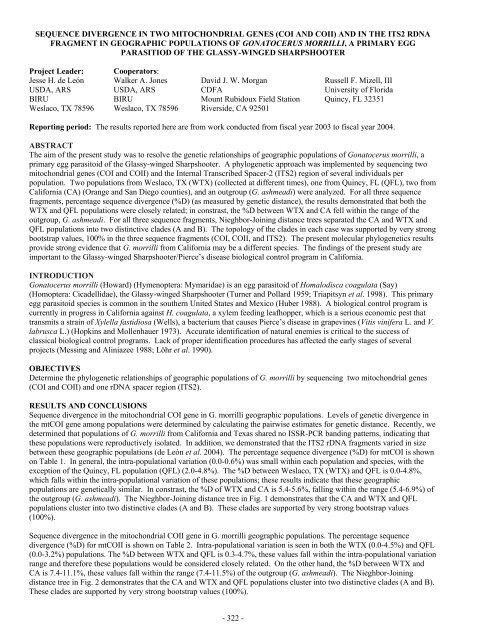Impact Of Host Plant Xylem Fluid On Xylella Fastidiosa Multiplication ...
Impact Of Host Plant Xylem Fluid On Xylella Fastidiosa Multiplication ...
Impact Of Host Plant Xylem Fluid On Xylella Fastidiosa Multiplication ...
You also want an ePaper? Increase the reach of your titles
YUMPU automatically turns print PDFs into web optimized ePapers that Google loves.
SEQUENCE DIVERGENCE IN TWO MITOCHONDRIAL GENES (COI AND COII) AND IN THE ITS2 RDNA<br />
FRAGMENT IN GEOGRAPHIC POPULATIONS OF GONATOCERUS MORRILLI, A PRIMARY EGG<br />
PARASITIOD OF THE GLASSY-WINGED SHARPSHOOTER<br />
Project Leader:<br />
Jesse H. de León<br />
USDA, ARS<br />
BIRU<br />
Weslaco, TX 78596<br />
Cooperators:<br />
Walker A. Jones<br />
USDA, ARS<br />
BIRU<br />
Weslaco, TX 78596<br />
David J. W. Morgan<br />
CDFA<br />
Mount Rubidoux Field Station<br />
Riverside, CA 92501<br />
Russell F. Mizell, III<br />
University of Florida<br />
Quincy, FL 32351<br />
Reporting period: The results reported here are from work conducted from fiscal year 2003 to fiscal year 2004.<br />
ABSTRACT<br />
The aim of the present study was to resolve the genetic relationships of geographic populations of Gonatocerus morrilli, a<br />
primary egg parasitoid of the Glassy-winged Sharpshooter. A phylogenetic approach was implemented by sequencing two<br />
mitochondrial genes (COI and COII) and the Internal Transcribed Spacer-2 (ITS2) region of several individuals per<br />
population. Two populations from Weslaco, TX (WTX) (collected at different times), one from Quincy, FL (QFL), two from<br />
California (CA) (Orange and San Diego counties), and an outgroup (G. ashmeadi) were analyzed. For all three sequence<br />
fragments, percentage sequence divergence (%D) (as measured by genetic distance), the results demonstrated that both the<br />
WTX and QFL populations were closely related; in constrast, the %D between WTX and CA fell within the range of the<br />
outgroup, G. ashmeadi. For all three sequence fragments, Nieghbor-Joining distance trees separated the CA and WTX and<br />
QFL populations into two distinctive clades (A and B). The topology of the clades in each case was supported by very strong<br />
bootstrap values, 100% in the three sequence fragments (COI, COII, and ITS2). The present molecular phylogenetics results<br />
provide strong evidence that G. morrilli from California may be a different species. The findings of the present study are<br />
important to the Glassy-winged Sharpshooter/Pierce’s disease biological control program in California.<br />
INTRODUCTION<br />
Gonatocerus morrilli (Howard) (Hymenoptera: Mymaridae) is an egg parasitoid of Homalodisca coagulata (Say)<br />
(Homoptera: Cicadellidae), the Glassy-winged Sharpshooter (Turner and Pollard 1959; Triapitsyn et al. 1998). This primary<br />
egg parasitoid species is common in the southern United States and Mexico (Huber 1988). A biological control program is<br />
currently in progress in California against H. coagulata, a xylem feeding leafhopper, which is a serious economic pest that<br />
transmits a strain of <strong>Xylella</strong> fastidiosa (Wells), a bacterium that causes Pierce’s disease in grapevines (Vitis vinifera L. and V.<br />
labrusca L.) (Hopkins and Mollenhauer 1973). Accurate identification of natural enemies is critical to the success of<br />
classical biological control programs. Lack of proper identification procedures has affected the early stages of several<br />
projects (Messing and Aliniazee 1988; Löhr et al. 1990).<br />
OBJECTIVES<br />
Determine the phylogenetic relationships of geographic populations of G. morrilli by sequencing two mitochondrial genes<br />
(COI and COII) and one rDNA spacer region (ITS2).<br />
RESULTS AND CONCLUSIONS<br />
Sequence divergence in the mitochondrial COI gene in G. morrilli geographic populations. Levels of genetic divergence in<br />
the mtCOI gene among populations were determined by calculating the pairwise estimates for genetic distance. Recently, we<br />
determined that populations of G. morrilli from California and Texas shared no ISSR-PCR banding patterns, indicating that<br />
these populations were reproductively isolated. In addition, we demonstrated that the ITS2 rDNA fragments varied in size<br />
between these geographic populations (de León et al. 2004). The percentage sequence divergence (%D) for mtCOI is shown<br />
on Table 1. In general, the intra-populational variation (0.0-0.6%) was small within each population and species, with the<br />
exception of the Quincy, FL population (QFL) (2.0-4.8%). The %D between Weslaco, TX (WTX) and QFL is 0.0-4.8%,<br />
which falls within the intra-populational variation of these populations; these results indicate that these geographic<br />
populations are genetically similar. In constrast, the %D of WTX and CA is 5.4-5.6%, falling within the range (5.4-6.9%) of<br />
the outgroup (G. ashmeadi). The Nieghbor-Joining distance tree in Fig. 1 demonstrates that the CA and WTX and QFL<br />
populations cluster into two distinctive clades (A and B). These clades are supported by very strong bootstrap values<br />
(100%).<br />
Sequence divergence in the mitochondrial COII gene in G. morrilli geographic populations. The percentage sequence<br />
divergence (%D) for mtCOII is shown on Table 2. Intra-populational variation is seen in both the WTX (0.0-4.5%) and QFL<br />
(0.0-3.2%) populations. The %D between WTX and QFL is 0.3-4.7%, these values fall within the intra-populational variation<br />
range and therefore these populations would be considered closely related. <strong>On</strong> the other hand, the %D between WTX and<br />
CA is 7.4-11.1%, these values fall within the range (7.4-11.5%) of the outgroup (G. ashmeadi). The Nieghbor-Joining<br />
distance tree in Fig. 2 demonstrates that the CA and WTX and QFL populations cluster into two distinctive clades (A and B).<br />
These clades are supported by very strong bootstrap values (100%).<br />
- 322 -











